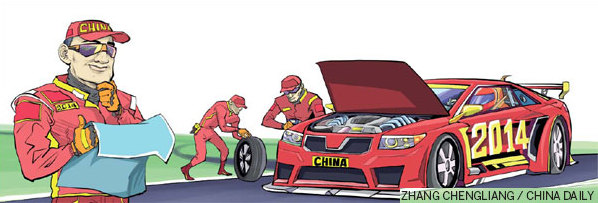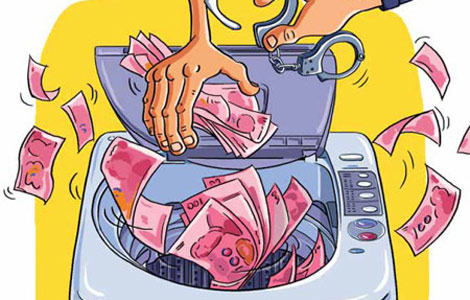3 routes in sight; 1 of them is a winner
Updated: 2014-01-17 09:28
(China Daily Europe)
|
|||||||||||

China faces some critical choices as it travels further down the road to reform
Is this the year in which China can convince the skeptics that it can make the transition to a modern, high-productivity economy? Or will powerful vested interests block change, prolonging structural weaknesses in the economy as aging places a growing burden on the country, and the environment degrades further?
China is at a crossroads. One road sign points to prosperity and the fulfillment of China's enormous potential. Another road sign points the opposite way, to stagnation and steadily lower growth. A third points in a direction between the other two: with enough reform, change and progress to avoid collapse, but not enough to fully overcome the considerable obstacles that China faces.
Two policy decisions, opening-up under Deng Xiaoping in the 1980s, and China's decision in November 1999 to join the World Trade Organization, have brought the country to a point where it has become a global economic and geopolitical force that stands alongside the United States as a superpower. Hundreds of millions of Chinese have emerged from stark poverty. The middle class hardly existed 25 years ago, but anyone in China today during a public holiday can see how many families have the time and the money to enjoy themselves.
But the effects of these far-sighted, brave policies have all but disappeared, leaving China as a very large developing country, with an annual per capita GDP of only $6,500, compared with $53,000 in the US and $43,000 in Germany. Meanwhile, huge economic and social challenges loom, such as providing vital services to its huge population - education, healthcare, affordable housing and old age care including pensions - not to mention the overdue clean-up of the polluted environment. Only a highly productive, efficient Chinese economy can underpin the demands that rising popular expectations bring. But much of China's economy is still far from efficient, and change is necessary.
The successful economic reforms in the 1980s and 1990s were based on the system that had evolved since 1949. They did not fundamentally change it. Former premier Zhu Rongji's harsh restructuring of the state-owned sector was aimed at making state-owned enterprises run better, not at dismantling them. The success of his policies mean that the economy is now dominated by a handful of state-owned companies that occupy dominant or monopolistic positions in major industries such as energy, natural resources, communications, logistics and travel, and strong, protected positions in industries such as real estate and banking.

China's high economic growth has been driven by high productivity growth, not from the state-owned sector, but from export-oriented industries, most of which are based in the seven coastal provinces stretching from Guangdong in the south to Liaoning in the north, plus Shanghai. Many foreign enterprises and Sino-foreign joint ventures in China have also made big contributions to growth and economic efficiency. Today the challenge facing China is to spread economic efficiency and high productivity from the private sector across the economic system and particularly to the SOEs. The best, indeed the only, way to do this is to break down market entry barriers and encourage private and foreign companies into key industries such as banking, telecommunications and energy, which have been protected from the harsh winds of competition. The Chinese economy badly needs more competition in many key sectors from well-resourced, leading companies to provide better product offerings at lower prices to end-users. Consumer choice stimulates spending and growth. Competition in fact makes operating companies stronger and better. There should be no need to protect companies in the state sector.
In fact, one of the most important parts of China's economy, banking, has already been disrupted by new private sector forces driven by new economic needs. Since 2008, the so-called shadow banking system has developed in China to meet huge unmet demand from private entrepreneurs for risk capital on the one hand, and on the other from savers and investors for much higher rates of return than returns offered by the formal banking sector. The government has responded by recognizing the value that many of these new financial institutions provide, and is bringing the better managed and capitalized ones within the bank regulatory system. It is a good example of how private enterprise, acting in its own interest, can be harnessed to provide the economy as a whole with the services that people need, enabling it to perform more efficiently. The result is more growth, more consumer satisfaction and a stronger, more efficient economy.
China's development since 1980 has built, mostly very successfully, on the existing system. What is new in 2014 is that progress involves a fundamental shift from an economy dominated by government-owned and government-directed enterprises to one in which the contributions of the private and foreign sectors are explicitly recognized as being as important as the state-owned sector. The next step for China depends on a shift in traditional ideas about economic ownership. It requires an even bigger change than before. The recognition of private property rights is a fundamental part of this shift. But how does a society come to terms with the idea of individual and corporate ownership, not as sub-ownership or leasehold as now, but in the meaning of outright or absolute ownership? Can the government withdraw as an owner and operator within large parts of the Chinese economy, to focus on policy-setting, organization, control and regulation? That is a big task for bureaucrats who like the power that goes with controlling key economic sectors.
Nor are China's challenges just domestic ones. China is such a populous and geographically strategic country that its destiny is inevitably bound up with that of its neighbors and the rest of the world. The key among all the changes taking place in the new, multi-polar world is the relationship between the two superpowers, China and the US. What happens in the other big economy, the US, will always have much meaning for China. Today, five years after the 2008 crash, America's economic fortunes have begun to revive. Last year the US grew by about 2.7 percent, and this year the figure should exceed 3 percent. US budget sequestration, which occurred last year as a result of the standoff between the two main parties in Congress, cut US government spending across the board. The US government budget deficit has started to shrink. New technologies involving horizontal drilling and shale oil production have changed the US's economic outlook. In a few years it will become not only the world's largest producer of oil, and be self-sufficient, but also an oil exporter, once Congress revokes outdated laws that forbid oil exports. The country's energy exports will sustain a balanced US current account with the rest of the world, underpinning the US currency and reducing direct US economic dependence on major oil exporters, particularly in the Middle East. US politics will remain tortuous. But the next presidential election in 2016 could bring a president who can unite the country. Stronger economic growth, shrinking deficits and a stronger, more united government will produce a new period of US resurgence.
A stronger US dollar need not threaten the globalizing Chinese renminbi, because smaller US deficits will reduce the quantity of dollars flowing from the US into the rest of the world. In turn this will create a need for another widely accepted currency, like the renminbi, to fill the gap in saving and trade settlement created by a shrinking quantity of dollars. The development of the renminbi as a global currency can continue in the presence of a strong dollar.
But will the development of US energy independence confirm the tendency of many Americans to look inward, making the US less prepared to co-operate with China? Nearer to home, how will the US position itself in the deteriorating relationship between China and Japan? With neither Japan nor China prepared to give any ground, US mediation seems to be an important part of any long-term agreement between the Japanese and the Chinese.
Will the Europeans prove any more receptive this year to the idea of a Europe-China trade agreement that could greatly benefit both sides? Or will China's progress in Europe continue to depend on the relatively slow development of unilateral agreements, for instance with Switzerland and the UK?
During 2014 we will start to get a good sense about which of the three road signs China will follow. But China, drawing on its long history and on the last 30 years of stunning achievement, can surprise onlookers on the upside, as it has before.
The author is a visiting professor at Guanghua School of Management, Peking University. The views do not necessarily reflect those of China Daily.
(China Daily European Weekly 01/17/2014 page18)
Today's Top News
Xi writes to Chinese in German colleges
China software to rival Android
Will China dominate the world?
Mainland policy lures HK students
Obama tells Germans he will not wiretap
Party is over for SOEs conferences
Egypt referendum wins support
Home prices continue to climb
Hot Topics
Lunar probe , China growth forecasts, Emission rules get tougher, China seen through 'colored lens', International board,
Editor's Picks

|

|

|

|

|

|





